Where to shop to find a preloved bargain
Posted by Victoria Lochhead on
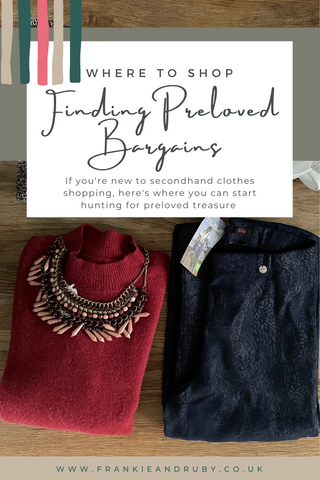
We've all got that one friend who turns up looking fantastic, and they say something like, "What this designer coat? Oh I picked it up in a charity shop for a couple of pounds." So, what's the secret? How is it possible to find amazing preloved clothes and where do you go to find them? In this extract from my book In the Jumble, we explore a few of my favourite places to go treasure hunting.
Buying pre-loved clothes doesn’t just mean popping down to your local British Heart Foundation and having a quick rummage through the jumpers. There are loads of different ways you can find and buy excellent second hand clothing, I’ve tried them all and can safely say that some dig up more treasure than others. Some, like the jumble sale, are really for the more intrepid hunter, whilst finding a good local dress agency will feel just like walking into a high-end boutique and is usually a great place to start.
Most people’s idea of turfing up a bargain comes from charity shopping. If you live in or near a town, I can guarantee you’ll have a charity shop or two near you. There’s a handy link to find some of the charity shops in your area. The main exciting advantage with charity shopping is that you never know what you’ll find as the stock is updated several times a day, so if you went in yesterday, chances are there will be different pieces in there today. It’s a never-ending source of fun.
Nowadays a lot of charity shops have sorted their clothes by type and colour so it’s easy to see what you’re looking for. My local Cancer Research shop is a pleasure to browse around. The other thing I love about charity shops is that they usually have large windows that let in lots of natural light to the shop so you can get a good look at colours and fabrics before purchasing. There are usually changing rooms in charity shops now, and most will let you take things back if you keep the receipt and the label on it. Going to charity shops that have affluent houses nearby are often a great place to find a designer bargain; this guide to the best charity shops in London might be a great place to start if you're after something really amazing. Personally, I like going to towns like Marlow or Henley with a good number of charity shops in one place, or better yet, the Oxfam Superstore in Oxford, which is huge.
If charity shopping still feels like a step too far for you, then I’d recommend you start with a dress agency. Dress agencies will accept clothes from clients, which they then sell on their behalf, usually splitting the income 50/50. This means that what you tend to find in dress agencies are clothes that people have spent a lot of money on originally, or clothes that are still new with the labels on, and the owners are hoping to recoup a bit of cash for. All the dress agencies I know (my own included) have an admission policy of what they will accept for sale, so it’s usually high-end high street, boutique and designer labels only, and they have to be in as new condition. You can expect to pay more than charity shop prices in a dress agency, but still nowhere near what the item would have cost originally. Dress agencies are laid out professionally, and are not usually rammed full of clothes, it’s a relaxed shopping experience where you may well find yourself a designer bargain or two. Type in Dress Agency and the name of your local town in to Google and you’ll be able to find one near you (you might even find an online one, like (ahem), well, ours ;-)). It’s a great place to get started in changing your shopping habits to pre-loved, you’re very likely to find something beautiful and unusual l too. If you want to wear more designer clothes but can’t quite reach the designer price tags, a dress agency is a great place to start looking.
If you’re a fan of online shopping, then the biggest second hand shop in the world awaits you; eBay. eBay is wonderful because it's open 24/7, you can be very specific in your search of what you want, and because there is so much on there, you’re probably going to find it. Just a few clicks and voila, page after page of glorious items to have a look at. And this can be a problem. It’s almost too easy to shop on eBay. I have a client who enjoys a bit of late night shopping on eBay after a glass of wine or two, and then can’t remember what she’s ordered until it arrives. She says it’s like Christmas when she opens the parcels because she’s genuinely forgotten what’s inside. As you can imagine, mixed results.
If you’re going to have a look on eBay, start with a really good idea of what you’re looking for. Typing in “blue ladies work dress size 14” sounds specific, but, honestly, you’ll get hundreds of results to trawl through. I recommend that you pick two or three labels that you love and you know work for your shape, then you can try searching for those, so a more specific search might be “Boden navy blue ladies work dress size 14”. I have a client who loves Vivienne Westwood, so I often search for that label to see what’s available. A bit like the charity shop, new things are added to eBay all the time, and you can set up alerts to notify you when something new comes online that you’re looking for. Put your search terms in the search box, see what comes up, and then click ‘follow this search’ to get updates on new things that meet your search terms. I recommend this as a good way to keep an eye on your favourite labels.
The downside of using eBay (and all online methods) is that you don’t get to see, feel or try the item until it arrives at your home. Sellers are required to post photographs and give a detailed description of the quality of an item and any defects, but to be safe, only buy from sellers who accept returns. At least then if it arrives and you’re not happy, you can send it back. I once ordered a silk Noli dress on eBay for a party. The seller had described it well, but when it came, some past owner had hand sewn the neckline together, which I had to unpick to get it on, leaving marks in the silk. I’d paid £45 for the dress, which is quite a bit in the second hand world, so I was disappointed with this one. On the other hand, I picked up a marvellous pair of L K Bennett shoes for £4.99, which the owner said were being sold cheap because they were badly scratched. When I got them, the scratches were hardly noticeable, and I was delighted with them. Don’t be afraid to ask the seller questions before you commit to buying something if you’re not sure of the condition, the colour or the quality. I sell regularly on eBay for my dress agency and people are always messaging me asking me to measure various unusual parts of the garment, which I’m always very happy to do.
If you buy something on eBay that you’re really pleased with you can mark the seller as a favourite, then you can search your favourite sellers to see what they’re selling at the moment. I once bought a beautiful Kew floral duster coat from a lady for £35. It arrived packaged in tissue paper by next day post and was exactly as described and photographed. I instantly made the seller one of my favourites, and found that she sold quite a bit of Kew and Jigsaw stuff, which I liked. It’s a great way to keep track of sellers that you know are reliable and deliver good quality items.
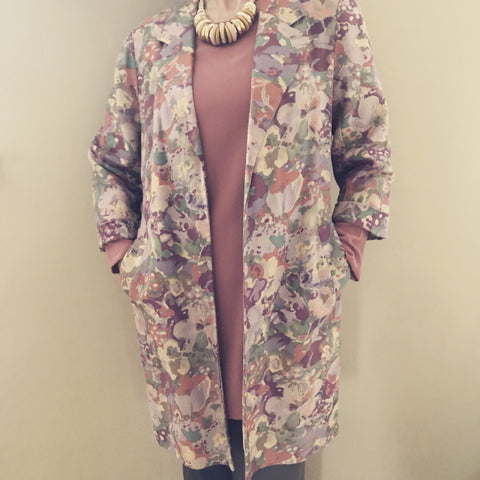
Of course there’s not just eBay online where you can shop second hand. There are literally hundreds of other sites. Some of the newer kids on the block like Vinted or Depop seem to do well especially for the younger audience, and I've bought quite a few things from Thrift+ which I think is a great site for both high street and designer clothes. Even on Facebook there are local groups that buy and sell and there are plenty of clothes sellers on there, usually selling things in lots. I quite like looking at Preloved but I do find I get waylaid with things like vintage armchairs and old sideboards when I’m looking. For those hunting for designer pieces, it's worth a browse on the Vestiare Collective website, although I haven't personally bought from there yet. One of the sites I really enjoy is the Oxfam online website http://www.oxfam.org.uk/shop. I can spend many a happy moment browsing the online vintage section. The search facility is great, it just feels like a regular online shop. I also like the fact that in the vintage section, you can shop by decade, or by fabric as well as the other regular search facilities – it’s a great website to start a bit of an online browsing addiction.
Let's say you've got a much loved treasure in the wardrobe already - threadbare and past it's best, and you would literally give a limb to find an exact replacement in the preloved world. Well, thanks to Google image search, you just might find it! When you go to Google search, there's now a camera icon in the search box - click on it to snap a photo of your treasure and it will give you image search results from thousands of websites. I have successfully used this method to find things for clients who have either spotted a dress they love in an old catalogue, or been desperate to replace a much loved mac.
If online shopping really isn’t your thing and you prefer the cut and thrust of physically being there and having a good old rummage, then look no further than the jumble sale.
When I was small, and I used to go to Jumble sales with my Nan, they were easy shopping territory for me. I could slip unseen through the throng of elbows and make my way to the front. Oh to have that skill again. So unless Harry Potter lends me his cloak of invisibility, as an adult, I have to resign myself to getting stuck in with the rest of them. If you’ve never been to a jumble sale before, imagine a polite rugby scrum, or the Gary Barlow fan club as he walks into a room. Yes, there’s some jostling. Yes, you might get your toe trodden on. You’ve got to be bold at a jumble sale – this is no time for timidity. Timidity gets you the back of the throng and only able to look at books or bric-a-brac. No, to get to the decent clothes in a jumble sale, you need a place at the front, you need to not mind other peoples elbows in your way, and you need to plant your feet very firmly.
If you go to a sale and the other buyers are old hands, what you find is that a sort of assembly line forms at the jumble. In front of you is a wonky trestle table about to collapse under the weight of about a ton of clothes, and you need to find some treasure in it. That means handling and looking at as much as possible as quickly as possible before it’s snapped up by the person who is standing right over your shoulder and ready to pounce. Professional jumble salers take the top item on the pile in front of them, examine it, and move it to the right so that they can look at the next item. The person to their right, then picks up their discarded item, examines it and moves it along, thus creating a sorting system, which means that nearly all unwanted items end up on the right. My advice, start as far left as you can and get sorting. Woe betides the left-handed person at the jumble who sorts from right to left.
As you may have guessed by now, a jumble sale is not in any way rookie territory. You’ve got to know what you’re doing at a jumble sale. It’s easy to spot the inexperienced hunter; they don’t bring a bag, or try to pay for a 10p top with a £20 note. They wave their arms over the throng and just grab items at random, upsetting the production line system. No friends, don’t do this. If you’ve never been to a jumble before, go with someone who has, or go knowing that this is how it all works. Get there early, take plenty of loose change, get your place at the table, and just rummage. If you like the look of something, sling it over one arm until either it’s too big a pile and you can’t hold it anymore, or until you’re done and then pay for it all in one go. It sounds like hard work because it is. It is physically demanding and not for the claustrophobe, but most jumbles helpfully put on a tea and cake stall so you can revive yourself before going in for round two. I recommend going round everything twice, because there is just so much stuff at a jumble, you’re bound to miss something the first time around.
I can hear you now.
You’re saying, Oh my goodness V, is it worth putting yourself through all this? Why on earth would you do that? And I would say to you, because it’s really good fun! Honestly. I love the way it works, and the firm but polite old ladies who fiercely guard their space. I love the thrill of not knowing what I’m going to find and the fact it’s all in a pile, just waiting to be discovered. I love the people who run the jumbles who are always smiling, armed with dozens of old plastic bags for anyone who turns up without one.
My favourite jumble sale is one held twice a year in the village where we go on holiday. And, what do you know; our holidays match the dates of the jumble – what a co-incidence! I always leave this jumble with bags and bags of treasure, and then wish I hadn’t walked the mile to get there and brought the car instead. And how much does this most pleasant of past times cost? I’ve never spent more than £4. £4 was a mother lode of a haul from this jumble sale. Most items are 10p or 20p, and the most I’ve paid in a jumble for an item of clothing was 50p. It’s cheap as chips. Yes, it is a jumble so there are no rules on quality. You’ve got to wade through holey jumpers and bobbly skirts to find your treasure, but let me promise you – treasure is there! I’ve bought a beautiful cream Hobbs cardigan (10p), a white stuff top (10p), a lovely floral M&S skirt (10p), a designer merino wrap (20p), and a red leather M&S handbag (10p) to name but just a few items from jumble sales. If you’ve the constitution of a Jane Austen character, jumbles are not for you, but if you’re strong and brave and you love a bargain, dive in my friends, dive in.
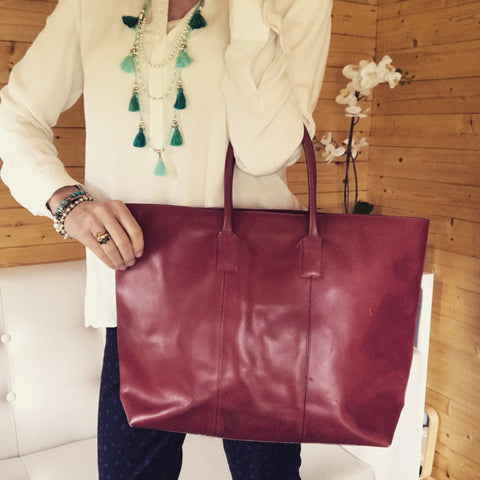
There’s no online directory for jumbles, but start with the what’s on listings for your local paper, or look round local church halls. Most jumbles are advertised with A4 posters stuck to lampposts or put up in the local shop, so start digging around your area, and you’re bound to stumble on a jumble sooner or later. Often the same jumble will be held at the same time each year, so check with the organizers when the next one is on.
Another possible source for your new hobby is the car boot sale. I don’t see as many car boot sales in my area as I used to, I don’t know about you. Maybe I’m just not up and about early enough on a Sunday morning. The thing I love most about car boot sales is seeing what people have tucked under their arms on the trek across the rutted muddy field back to their car. I’ve bought a dolls house before (that was a challenge) and I’ve seen people buy lawnmowers, climbing frames, even once an inflatable crocodile.
If you’ve ever read the Enid Blyton book “The Faraway Tree”, you’ll know that in it there’s the land of take what you want, where the characters wander round and find everything they could possibly want. I’m sure Enid must have been to a car boot or two in her time to inspire this story, or perhaps she inadvertently invented the idea of the car boot sale. You can literally find anything you want at a car boot sale. I’ve even see people sell the car they’ve arrived in (although I’m not sure how they get all their unsold stuff or themselves home afterwards).
Car boots are a pleasant enough way to spend an early weekend morning. I guarantee you’ll get some great books, maybe even a foot spa, certainly a few heavily loved Barbie’s along the way. But when it comes to clothes, I usually find that a car boot can be slim pickings. By the time you’ve walked end-to-end of a fairly decent sized sale, you’ve probably covered about nine miles, and all that looking can be exhausting. Clothes sellers are spread out, and most people will be selling clothes alongside a table full of bric-a-brac, so you’ve got to spot a wobbly rail at the end of someone’s table. Because the clothes have had to be transported, don’t expect them to be ironed or sorted, or have prices on. Don’t necessarily even expect them to be hung up: sometimes clothes are thrown in a pile on a tarpaulin.
In my experience, I’ve never found a really incredible bargain at a car boot sale. Except one pair of £3 cowboy boots that I wore to death, that’s been it. They’re not my favourite source of second hand clothes, because you a) have to get up very early, b) have to walk across farmers fields, dodging the cow pats to even get there, c) have to traipse up and down row upon row of men who’ve been told to clear out their shed or else d) it’s often in summer so usually hot and sweaty hunting e) clothes are brought along almost as an afterthought and stuck on the side of a trestle table covered in some child’s unwanted toys and books and f) because you’re buying directly from the owner, the prices vary hugely. Some just want to get rid of stuff and charge next to nothing, and at the next stall the owner might still have an emotional attachment or guilt over the original price of the item and charge ten times more. There never seems to be an average price at a car boot sale and there’s no benchmark on what to charge.
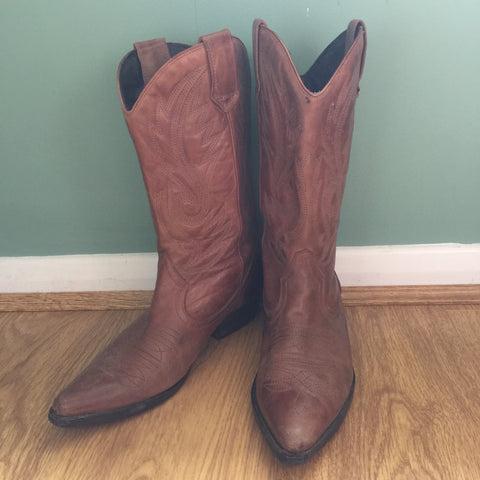
Have you been to a swapping party? Swapping (or swishing) is an incredibly fun way to find some lovely new to you clothes, and it has nothing to do with throwing your car keys onto the coffee table and throwing caution to the wind with someone else’s husband. A good swapping event is the ultimate in clothes recycling because you go armed with things that you don’t want from your own wardrobe, and bring home a bag of things you do want from someone else’s. The idea is that you swap things you don’t want any more with someone else. A well-organized swapping party is a growing trend and can be a fun social event and you can often find local ones happening on the events pages of Facebook. You might also spot local specialist sales, such as kilo sales (where you pay by weight), sample sales or returns sales often advertised locally or on Facebook.
If you get really into your second hand shopping life, you might like to try your hand at vintage. Buying vintage is a specialist past time, and buying true vintage can be the ultimate in treasure hunting. If you have a vintage shop near you, I strongly encourage you to go and check it out (go on, go!). You can almost see the history emanating from the clothes. I love imagining who bought and wore those clothes, where they wore them, and what sort of a person they were. You can build amazing stories around your vintage finds. Personally I find that vintage clothing doesn’t really suit me. I’m quite a straight body shape, and a lot of vintage styles have a defined (and alarmingly small) waist, which doesn’t look right on me at all. So the 50’s is out for me. And most of the 40’s. I’ve got twenties flapper girl or seventies hippy available to me and my shape. That’s good news as they’re my favourites. I love a pair of good flares, and the straight shapes of the 20’s with a bit of sparkle and fringing thrown in, who wouldn’t love that?
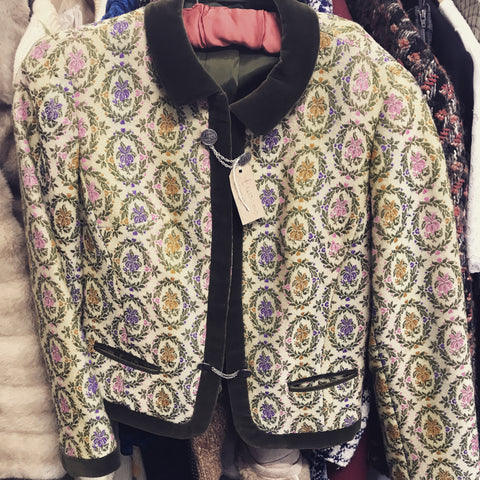
If you go to a good vintage shop near you, chances are that the person who runs the shop is often also the buyer of the stock. They know a thing or two about vintage, and they can help steer you to some finds that will work for you. Vintage works well if it’s mixed up with some more modern styles, and your vintage seller will not only help you choose something, but show you how to wear it too. My favourite vintage shop is a little place at the top of the high street in Totnes. `The last time I was there I spotted the most beautiful silk kimono (which I wish I’d bought and didn’t). What struck me most was one room at the back, which was full of vintage wedding dresses. These dresses were beautiful and I almost cried thinking of all the women who wore them on their special day.
My favourite vintage find was a checked wool jacket I bought from Bath Flea Market when I was about 17 (shows how long ago that was, as the flea market has been gone for years). It was a 1940’s jacket, beautifully made, and cost me about £2. I wore it and wore it and wore it. If I close my eyes now, I can still see the blue buttons on that jacket. I don’t remember now what happened to it, I just stopped wearing it and now I don’t have it anymore. I miss it like an old friend I’ve lost contact with. I wish I’d kept it; it was a work of art in itself. If you can find a piece of vintage you love as much as I loved that jacket, you’ve found real treasure indeed my friend.
As you can see, there are a multitude of places you can buy second hand clothes from. In fact you’re probably tripping over second hand clothes sellers on your way to the shops. See which one takes your fancy and give it a try. I’d recommend not necessarily starting online but perhaps finding a good local dress agency or well organized charity shop if this is your first foray into treasure hunting. You need to see and feel the items, try a few things on, learn more about what you like and what you don’t before leaping in to the deep end of jumble sales, car boots or online. Start looking around for good locations near you to practice your craft. And if you have some great suggestions for where to find amazing preloved bargains, tell us in the comments below!
If you enjoyed this excerpt, you can read the rest of the book for free on Amazons Kindle Unlimited platform.
Share this post
- 0 comments
- Tags: Buy Less New, Charity Shops, Clothes, Dress Agency, In the Jumble, Preloved Clothes, Second Hand Clothes, Second Hand Clothes Shopping Online, secondhand clothes shopping, Shopping, Sustainable Fashion
